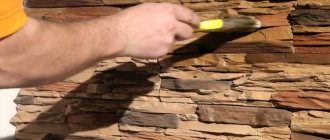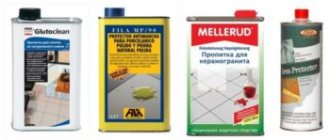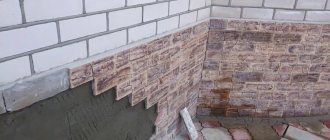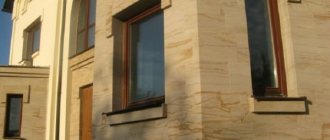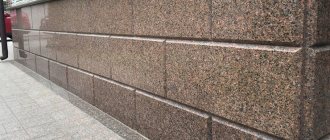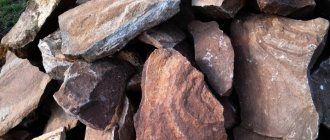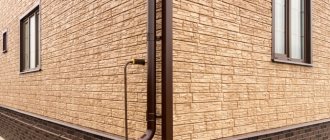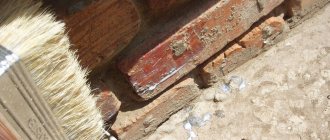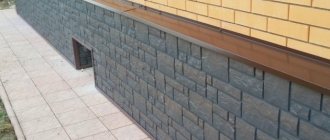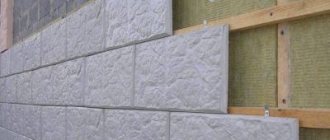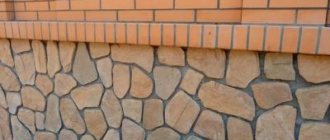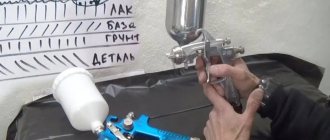Stone varnishing is used for two reasons. Firstly, in order to protect mineral finishing materials from rapid destruction under the influence of external environments. Secondly, to create a special appearance of the coating. Wet-effect varnish for stone is very popular today, both for exterior and interior decoration.
The chemical used as a varnish layer must have good physical and technical characteristics, otherwise all the work with decor will be in vain. Let's take a closer look at what kind of varnish this “wet stone” is?
Wet effect varnish protects the stone from external influences and improves its appearance
What is surface hydrophobization?
Today we’ll try to figure out what hydrophobization of natural and artificial stone surfaces is. The main purpose of hydrophobization is to protect the material from moisture
, because moisture entering the material can destroy it over time.
Go to category:
Water repellents
At the same time, we will show in practice how water repellents work with and without a wet effect, see photos.
To demonstrate the effect of impregnations, we took a granite slab on which Ager and Proseal water repellents will be applied.
Popular hydrophobic solutions
There are compositions that differ in their scope of application. Some of them are intended only for surface use, others for volumetric use, and others can be applied to the surface and penetrate into the tile, filling the porous structure of the coating.
The domestic market offers many different formulations.
| Name of water repellent | Peculiarities | Life time | Consumption, l/m2 |
| Aquasil | Concentrated powder, characterized by high efficiency and low alkali content. Economical, can be used for surface and volumetric application. The water-repellent properties of the tiles increase up to 20 times. When applied volumetrically, it prevents the appearance of darkening. | 10 years | 0,25-0,5 |
| Tiprom U | Organic based concentrate. Has increased dirt-repellent characteristics. | 10 years | 0,15-0,4 |
| Crystallisol | The drug is based on methyl silicone polymer and is available in liquid form in 1 or 10 liter packaging. It is characterized by increased resistance to chemical and atmospheric influences, has increased vapor permeability and non-flammability | Up to 10 years | 0,1-0,3 |
| Ceresit ST 10,11,12,13 (for surface treatment); CO 81 (for volumetric processing) | Can be administered as an injection through artificial indentations. | 12 years | 0,2-0,5 |
| VOKA | It is a universal impregnation with increased moisture resistance, applied in 1 layer. | 11 years | 0,03-0,05 |
Table - types of hydrophobic solutions and their features
Consumption is indicated depending on the porosity of the surface. All drugs, except for the Ceresit and VOKA brands, are domestic.
How to choose a water repellent? Main selection criteria
For example, we need to protect the granite base of a private house. Let's try to answer: “What to use for protection in this case”?
First of all, it is important to maintain “ vapor permeability”
"- the ability of the material to breathe. After all, if this is not provided for, the moisture that will come from the concrete will not be able to pass through the material, but will get stuck in it and, with a difference in temperature, will destroy it.
Therefore, we look at the instructions, if the impregnation does not provide “vapor permeability”, we immediately discard this impregnation; “sealers” will not be suitable in this case.
The granite surface immediately after treatment with water repellents and removal of excess impregnation.
But the “problem of choice” does not end there. Now we need to determine what other “pollutants” we want to protect our surface from - we need to understand that we need a more expensive water repellent that can protect the surface not only from moisture, oils and other pollutants, or whether protection only from moisture is sufficient.
The next step is to determine whether we need the “ wet stone”
“(manifestations of the color of the processed material and/or its “strengthening”) or we do not want to change the decorative properties of the material, but only want to protect it.
Go to category:
Impregnation "Wet stone"
And even at this stage our choice does not end; now we need to determine whether we can completely dry the material being processed, because for a humid environment it is necessary to use a water- based
", and if the surface can be dried well, then you can use a
solvent
.
Granite surface 2 hours after treatment. Ager – with a wet effect, Proseal – without a wet effect.
Ways to protect paving slabs
Preventive impregnation of the paving surface prevents its rapid abrasion and protects against minor mechanical damage. There are various means of protecting paving stones and tiles:
- Cleansing. Remove old contaminants such as grease, salt and chemical deposits.
- Anti-mildew. They are used for processing tile seams and butt joints of paths and blind areas.
- Water repellents. Apply immediately before putting road surfaces into operation.
- Special means for protecting tiles and paving stones.
Hydrophobic agents increase the moisture resistance of coatings. The older the tile or stone, the more often the coating will require treatment with a protective compound.
Composition and principle of action of water repellents
To summarize, a water repellent is an impregnation consisting of “solvents” and polymers. Solvents are conductors that allow polymers to be delivered deep into the material, and after completing their task, they evaporate. Polymers are an immediate shield.
Types of water repellents
Water repellents are divided into 2 large groups:
- Color enhancers (water repellents that change the appearance of the material (they are also called “wet stones”);
- Water repellents that preserve the natural color of the material.
Each of these groups is divided into water-based and solvent-based impregnations (organic based (usually used for kitchen surfaces) and inorganic (usually the most resistant).
Hydrophobizing effect of impregnations with a wet effect and without the effect of a wet stone
What are the types of efflorescence?
The main factors that determine the types of efflorescence are the main chemical component and the surface material.
In concrete mixtures, lime deposits are formed due to an excess of calcium hydroxide.
On building products made of cement (on plastered, putty surfaces) - under the influence of water-soluble salts:
- chlorides;
- carbonates;
- nitrates;
- sulfates.
In clinker they appear under the influence of alkali sulfates.
Rating of the best water repellents
As mentioned earlier, today there are a large number of water repellents on the market, but the most popular for natural stone (granite, marble and agglomerate) in Russia today are water repellents from the three main manufacturers of chemicals for natural stone: Tenax, Bellinzoni
and
Akemi
.
Go to category:
Impregnations TENAX Impregnations AKEMI Impregnations BELLINZONI
These companies have been selling specials for many years. preparations for natural stone both in Russia and around the world, have enormous practical experience in working with these materials.
After all, when choosing a water repellent, it is very important not only the first tests (immediately after applying the impregnation), but namely the tests done through 3,6,12,24
and
60
months - only then will we be able to appreciate this or that drug.
Our rating includes:
The best water repellents that preserve the natural color of the material:
- Proseal by Tenax;
- NanoEffect by Akemi;
- Idea Gold by Bellinzoni
Water-repellent effect of Proseal impregnation.
The best water-repellent agents that enhance the color of natural stone:
- Ager from Tenax (most resistant to sun);
- Transformer by Akemi;
- IDEA StoneAger from Bellinzoni.
The water-repellent effect of Ager impregnation
Today, the Russian market offers a great variety of natural granites and marbles from all over the world, and what one or another seller coated it with when selling it is not always possible to determine at first glance, therefore, before applying a water-repellent agent to the surface of the material, we always recommend first take a test
(carry out a trial test of the composition specifically on your material) on a small area to make sure whether this or that water repellent is suitable for you, whether the color of the coated material suits you and whether the coating will “lay” on your material.
Important:
if the surface of the material has already been previously coated with a protective water repellent that preserves the natural color, then without preliminary mechanical treatment you will no longer be able to apply another coating on top in order to obtain a “Wet” effect (color enhancement).
Winter care: removing ice and snow
The main enemies of paving during the cold season are snow and ice. If in the case of asphalt or concrete pavement it is permissible to use rough mechanical influences on the ice (for example, chipping it with a crowbar), then such methods are not suitable for paving slabs, since they lead to damage to its front side. To remove snow from the surface of paving slabs, shovels made of wood or plastic are used that do not destroy the artificial surface.
Snow collected from the surface of the tiles is spread onto nearby lawns or completely removed from the yard. If the sidewalk is located next to the roadway, it is cleared of snow using special machines designed for cleaning sidewalks.
Salt and strong reagents are “destroyers” of tiles
In winter, paving slabs are especially vulnerable. It is easy to find special chemicals in stores that will help remove ice from the surface of the coating. But when choosing a cleanser, you shouldn’t go for cheapness. It is better to ask the seller in detail about the features of a particular reagent. The wrong choice of product can irreversibly damage the beautiful tile coating: it can cause it to fade, after which it will be impossible to restore the previous shade.
It must be said that such a popular method of dealing with ice as sprinkling paths with salt is dangerous for paving slabs - salt harms the outer layer of the coating, especially if it is used often enough.
Hydrophobization as an effective care product
Care for tiles in winter should be taken care of in advance. The surface of paving slabs is dotted with many pores, which means that moisture easily seeps into the coating, which, when frozen, can lead to its destruction. Therefore, after laying paving slabs, it makes sense to apply a layer of modern waterproofing agent, which reliably closes the pores in the tiles, preventing moisture from penetrating inside.
How to apply a water repellent to the surface of a stone
Impregnations Ager and Proseal have proven themselves as excellent water repellents
Important:
Natural stone can have different densities (different absorbent properties) even within one slab (one slab), so we recommend applying the coating to areas of no more than three square meters at a time.
The water repellent should be applied in the following order:
- Impregnation was applied to an area of 3 square meters;
- We waited 2 minutes and wiped off any excess from the surface that the material could not absorb;
- And only after that we move on to the next section.
Only in this case can it be guaranteed that after application the material will not become spotty, there will be no sticky or greasy stains. After you have covered the entire surface for the first time, we recommend repeating the procedure to achieve a better “protective” effect.
Varnish for stone with a “wet” effect
Very often, in order to give a more aesthetic appearance to stone finishing (house facade, fence, other fences or decorative buildings, flooring, tiles), it is coated with a special varnish, giving the stone a wet, silky effect.
Very often, in order to give a more aesthetic appearance to stone finishing (house facade, fence, other fences or decorative buildings, flooring, tiles), it is coated with a special varnish, giving the stone a wet, silky effect.
Aesthetics are good, but do not forget that by covering decorative or natural stone with varnish, you thereby obtain excellent protection for the building material. It is not destroyed by weather factors or mechanical influence and lasts a long time.
Tips for using impregnation
For coating treatment to be effective, certain conditions must be met:
- Before use, it is recommended to test the impregnation on an inconspicuous area.
- The surface to be treated must first be prepared, including covering up cracks and chips. Freshly laid tiles can be immediately covered with a finishing layer, bypassing the additional processing stage.
- If you urgently need to treat a poorly dried surface, you can use Neogard impregnation. It should be noted that this method is short-lived.
- It is recommended to apply any impregnation in a generous layer, trying to avoid the formation of drips.
- To ensure that the applied layer dries faster, excess impregnation should be removed from the treated surface. Removal can be done with a sponge, gently blotting the surface.
For newly laid coatings, paving fragments can be treated with a water repellent using the volumetric method: place the tiles in the solution for a few seconds, then remove them and pave the marked area.
